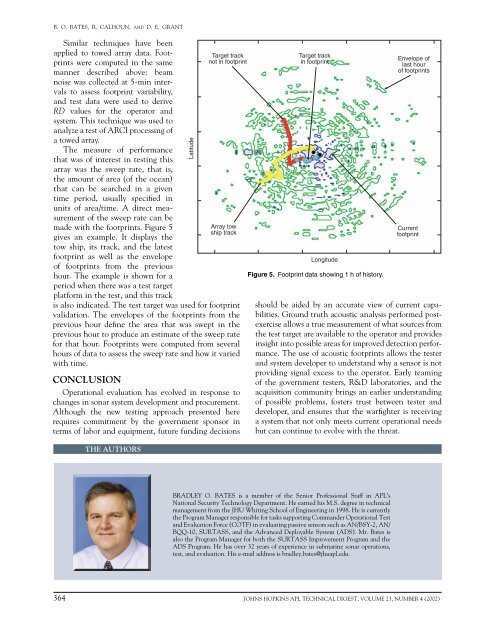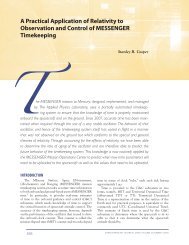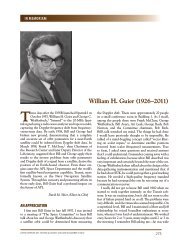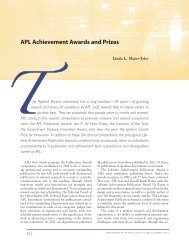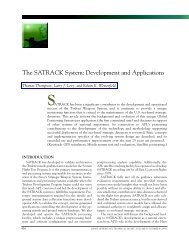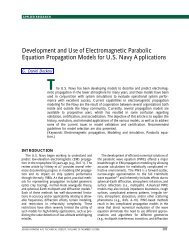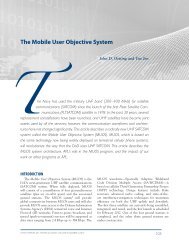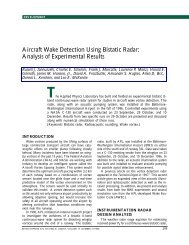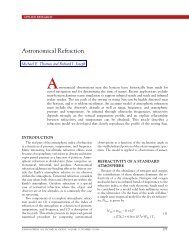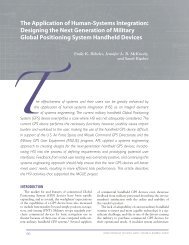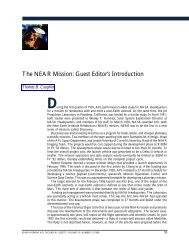Operational Evaluation for Evolutionary Sonars - Johns Hopkins ...
Operational Evaluation for Evolutionary Sonars - Johns Hopkins ...
Operational Evaluation for Evolutionary Sonars - Johns Hopkins ...
Create successful ePaper yourself
Turn your PDF publications into a flip-book with our unique Google optimized e-Paper software.
B. O. BATES, R. CALHOUN, AND D. E. GRANT<br />
Similar techniques have been<br />
applied to towed array data. Footprints<br />
were computed in the same<br />
manner described above: beam<br />
noise was collected at 5-min intervals<br />
to assess footprint variability,<br />
and test data were used to derive<br />
RD values <strong>for</strong> the operator and<br />
system. This technique was used to<br />
analyze a test of ARCI processing of<br />
a towed array.<br />
The measure of per<strong>for</strong>mance<br />
that was of interest in testing this<br />
array was the sweep rate, that is,<br />
the amount of area (of the ocean)<br />
that can be searched in a given<br />
time period, usually specifi ed in<br />
units of area/time. A direct measurement<br />
of the sweep rate can be<br />
made with the footprints. Figure 5<br />
gives an example. It displays the<br />
tow ship, its track, and the latest<br />
footprint as well as the envelope<br />
of footprints from the previous<br />
hour. The example is shown <strong>for</strong> a<br />
period when there was a test target<br />
plat<strong>for</strong>m in the test, and this track<br />
THE AUTHORS<br />
Target track<br />
not in footprint<br />
Array tow<br />
ship track<br />
is also indicated. The test target was used <strong>for</strong> footprint<br />
validation. The envelopes of the footprints from the<br />
previous hour defi ne the area that was swept in the<br />
previous hour to produce an estimate of the sweep rate<br />
<strong>for</strong> that hour. Footprints were computed from several<br />
hours of data to assess the sweep rate and how it varied<br />
with time.<br />
CONCLUSION<br />
<strong>Operational</strong> evaluation has evolved in response to<br />
changes in sonar system development and procurement.<br />
Although the new testing approach presented here<br />
requires commitment by the government sponsor in<br />
terms of labor and equipment, future funding decisions<br />
Latitude<br />
Target track<br />
in footprint<br />
Longitude<br />
Figure 5. Footprint data showing 1 h of history.<br />
should be aided by an accurate view of current capabilities.<br />
Ground truth acoustic analysis per<strong>for</strong>med postexercise<br />
allows a true measurement of what sources from<br />
the test target are available to the operator and provides<br />
insight into possible areas <strong>for</strong> improved detection per<strong>for</strong>mance.<br />
The use of acoustic footprints allows the tester<br />
and system developer to understand why a sensor is not<br />
providing signal excess to the operator. Early teaming<br />
of the government testers, R&D laboratories, and the<br />
acquisition community brings an earlier understanding<br />
of possible problems, fosters trust between tester and<br />
developer, and ensures that the warfi ghter is receiving<br />
a system that not only meets current operational needs<br />
but can continue to evolve with the threat.<br />
BRADLEY O. BATES is a member of the Senior Professional Staff in APL’s<br />
National Security Technology Department. He earned his M.S. degree in technical<br />
management from the JHU Whiting School of Engineering in 1998. He is currently<br />
the Program Manager responsible <strong>for</strong> tasks supporting Commander <strong>Operational</strong> Test<br />
and <strong>Evaluation</strong> Force (COTF) in evaluating passive sensors such as AN/BSY-2, AN/<br />
BQQ-10, SURTASS, and the Advanced Deployable System (ADS). Mr. Bates is<br />
also the Program Manager <strong>for</strong> both the SURTASS Improvement Program and the<br />
ADS Program. He has over 32 years of experience in submarine sonar operations,<br />
test, and evaluation. His e-mail address is bradley.bates@jhuapl.edu.<br />
Envelope of<br />
last hour<br />
of footprints<br />
Current<br />
footprint<br />
364 JOHNS HOPKINS APL TECHNICAL DIGEST, VOLUME 23, NUMBER 4 (2002)


